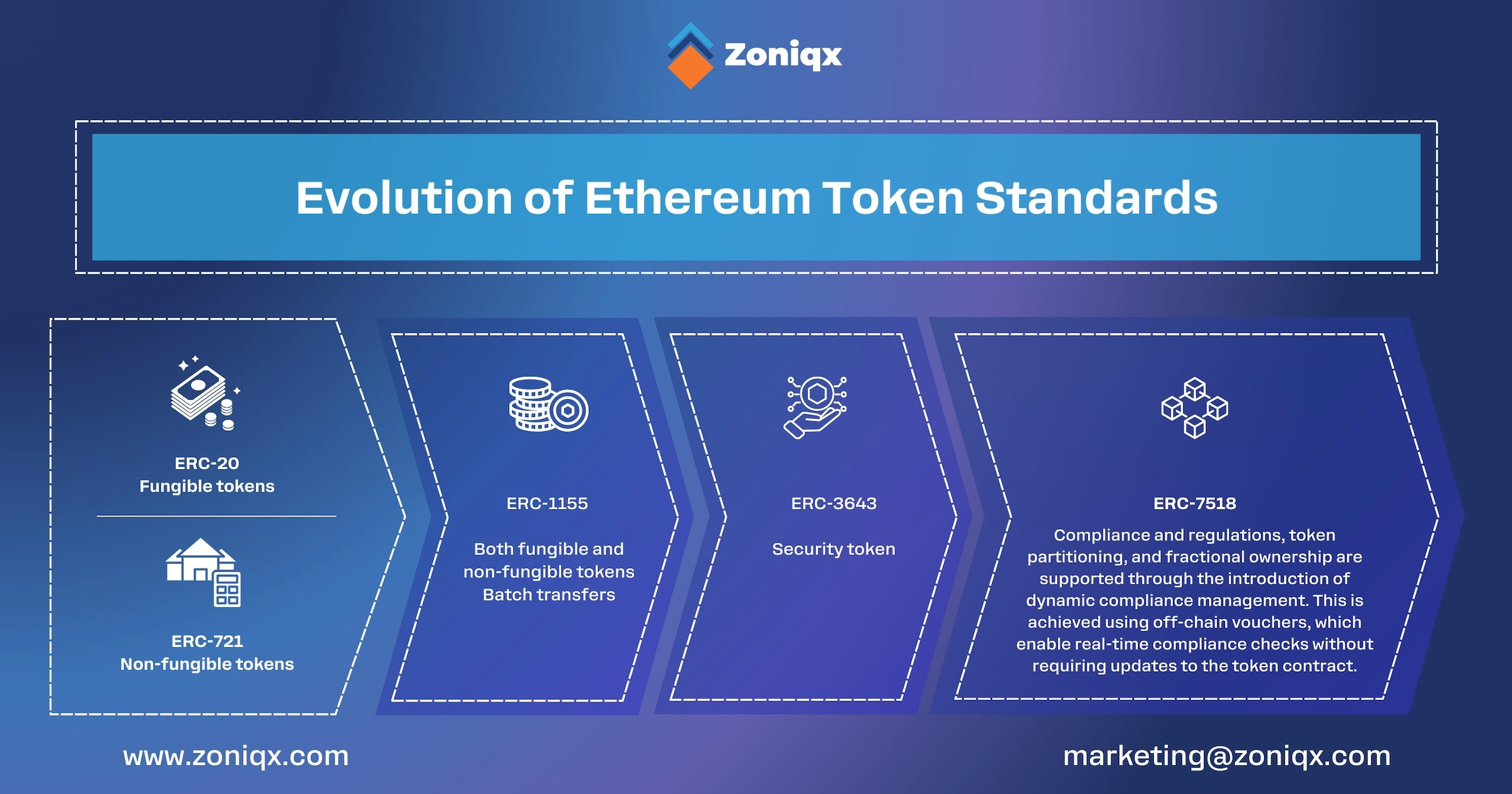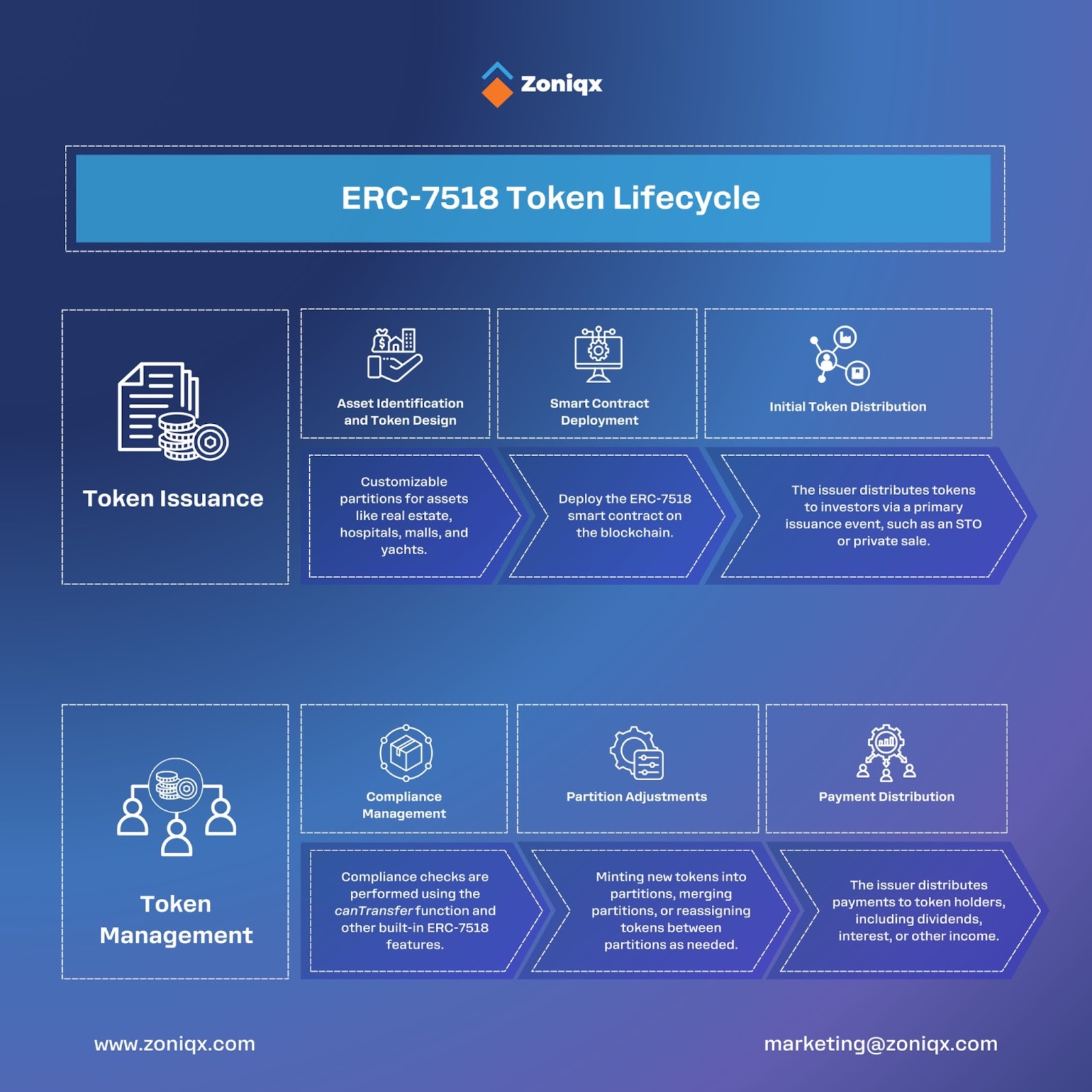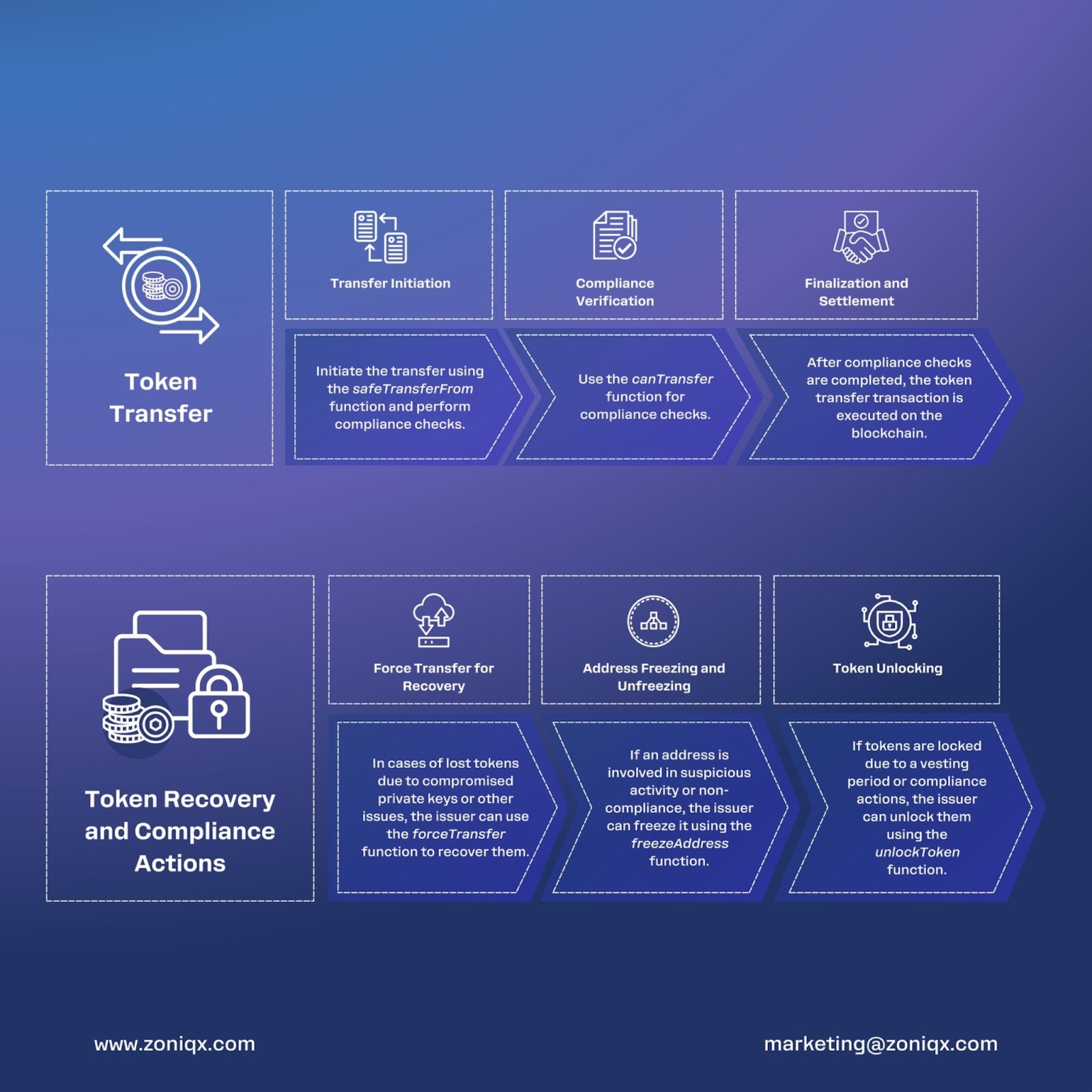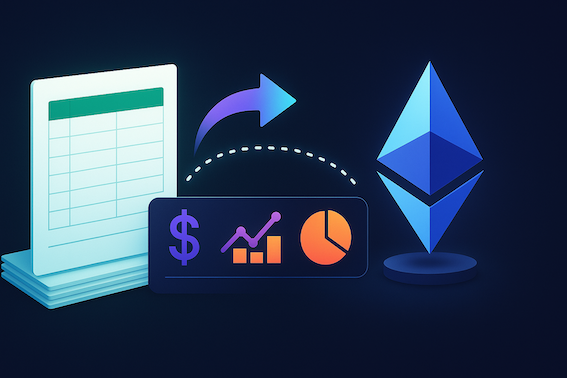Tokenization Standards: ERC-20, ERC-721, ERC-1400, and Why ERC-7518 Is the Next Step
Token standards are the rails that make digital assets interoperable, secure, and programmable. If you’re exploring real-world asset (RWA) tokenization, three standards dominate most conversations: the ERC-20 token (fungible), the ERC-721 NFT (non-fungible), and ERC-1400 (security-token focused). But for institutions that need compliance, partitioned ownership, and cross-chain portability, the standard to watch is Zoniqx’s proprietary ERC-7518 (DyCIST), a security-token framework that extends ERC-1155 to bring dynamic compliance and interoperability to regulated assets.
Below is a practical overview of these asset token standards, their core use cases, and how ERC-7518 connects the dots for enterprise-grade security tokens.
The Building Blocks
ERC-20 (fungible tokens)
What it is. The ERC-20 interface defines how identical, interchangeable tokens behave (balances, transfers, and allowances) enabling wallets, exchanges, and DeFi apps to work with them consistently.
Where it shines. Currency-like units, reward points, stablecoins, and governance tokens, any use case where one token is identical to another.
Typical RWA use. Cash-flow distributions, fractional fungible claims (e.g., fund shares), and payment rails inside tokenized marketplaces.
ERC-721 (non-fungible tokens, NFTs)
What it is. ERC-721 defines unique tokens (each tokenId is distinct); it is perfect for provenance, uniqueness, and one-of-one ownership.
Where it shines. Digital collectibles, identity credentials, property deeds, and certificates.
Typical RWA use. Singly identifiable assets such as unique real estate parcels, serialized equipment, luxury goods, or IP licenses.
ERC-1400 (security-token family)
What it is. A set of interfaces for regulated instruments: adding transfer restrictions, document references, partitioned tranches, and operator roles to support compliance workflows. Think cap-tables, investor eligibility checks, and regulated transfer rules.
Where it shines. On-chain securities where you need rule-based transfers, error signaling, and auditable documentation.
Typical RWA use. Private equity shares, credit instruments, revenue-sharing notes, anything under securities laws that needs transfer controls.
Why Multi-asset Foundations Matter?
Before we dive into ERC-7518, it helps to understand ERC-1155, the “multi-token” standard that supports fungible, non-fungible, and semi-fungible assets in a single contract. It adds batch operations, reduces deployment costs, and lets each tokenId behave like its own class of asset with separate metadata and supply.
This flexibility makes ERC-1155 a powerful base for security tokens that need partitions, classes, and programmatic rights, exactly where ERC-7518 comes in.
ERC-7518 (DyCIST): Dynamic, Compliant, and Interoperable Security Tokens
What it is. ERC-7518 (DyCIST: Dynamic Compliant Interoperable Security Token) is a token standard that extends ERC-1155 to model compliant, semi-fungible security tokens with partitioning (e.g., classes/series/tranches) and cross-chain operability in mind. Each tokenId acts as a partition with its own rights, restrictions, and compliance logic.
Why it matters. Traditional security-token interfaces often stop at “restrict transfers.” DyCIST goes further by:
- Dynamic compliance. Compliance checks (KYC/KYB, jurisdiction, accreditation, lockups) are enforced at transfer time and can evolve as rules or investor status change.
- Partition-aware tokens. Model tranches, classes, or series natively (per-tokenId), including different corporate actions across partitions.
- Interoperability by design. Architected for cross-chain and wrapping/bridging scenarios so tokens can move between networks without breaking compliance state.
Zoniqx’s overview of DyCIST highlights exactly these features for RWA tokenization: dynamic compliance, partitioned tokens, and cross-chain operability. These help issuers avoid regulatory pitfalls while staying flexible.
ERC-7518 brings the cap-table intelligence and rules you expect in traditional markets directly into the token’s interface, and keeps those rules portable across chains.



How Does ERC-7518 Compare with Other Contemporary Standards?
ERC-7518 vs. ERC-20
- ERC-20 is simple and battle-tested but fungible-only and lacks native compliance hooks.
- ERC-7518 keeps multi-asset flexibility (via ERC-1155) and adds transfer-time compliance and partitions, making it far better for regulated instruments than a bare ERC-20.
ERC-7518 vs. ERC-721
- ERC-721 uniquely identifies assets (perfect for deeds and 1/1 items) but has no built-in compliance framework and does not natively model tranches.
- ERC-7518 can represent semi-fungible slices with partition-specific rules, which is closer to how traditional securities are structured.
ERC-7518 vs. ERC-1400
- ERC-1400 pioneered security-token mechanics (partitions, operator roles, docs), but cross-chain portability and dynamic compliance are not core to the interface.
- ERC-7518 builds on the multi-asset semantics of ERC-1155, emphasizing interoperability and runtime compliance, making it a modern fit for multi-chain capital markets.
What Are Some RWA Use Cases?
1. Multi-class private funds
Model each share class or series as a partition (tokenId) with its own fee waterfall, voting rights, and transfer windows. Investors can hold multiple partitions in one wallet; administrators can run partition-specific corporate actions (distributions, redemptions) through the token interface. (ERC-7518 on ERC-1155.)
2. Tranche-based credit
Represent senior, mezzanine, and junior tranches as distinct partitions with different eligibility and risk profiles. Program lockups and ongoing suitability checks so transfers only execute if all rules pass. (ERC-7518 / ERC-1400.)
3. Securitized RWAs with cross-chain settlement
Issue on a permissioned L2 for primary distribution and bridge to a public chain or alternative L2 for secondary liquidity, while preserving compliance state and transfer controls. This is the core design goal of DyCIST.
4. Bond programs and structured notes
ERC-3475 focuses on bonds; ERC-7518 can complement this by layering dynamic eligibility and partitioning for coupon classes or callable features.
5. Unique physical assets with compliance
Use ERC-721 to represent a deed and wrap it in a 7518 partition to enforce who can receive it and when (jurisdiction, accreditation, sanctions lists), enabling compliant transfers of one-of-one RWAs.
How to Choose the Right Standard? A Quick Decision Guide
- You need simple fungible units (utility, governance, payments). Start with ERC-20 token, which is minimal, interoperable, and DeFi-ready.
- You need unique deeds or certificates. Use ERC-721 NFT, ideal for uniqueness and provenance.
- You need permissioned transfers for regulated instruments. Consider ERC-1400 or ERC-3643 if your stack already supports them.
- You need partitions, dynamic compliance, and multi-chain portability. Favor ERC-7518 (DyCIST) on an ERC-1155 foundation to future-proof issuance, secondary trading, and cross-chain movement.
What are the Implementation Pointers (issuer & developer checklist)
- Model partitions up front. Map each class/series/tranche to a distinct tokenId with its own metadata and rights. (Leaning on ERC-1155 semantics.)
- Externalize compliance logic. Keep KYC/KYB, sanctions, and jurisdiction checks modular so policies can change without redeploying the token. (Dynamic compliance concept in ERC-7518.)
- Design for bridges/wrappers. If tokens will move between chains, define how compliance state and partition data travel with the asset. (Interoperability focus in DyCIST.)
- Operator roles and auditability. Borrow proven ideas from ERC-1400 (operators, document links, error signaling) where relevant to governance and reporting.
- Use standard tooling. Where possible, rely on OpenZeppelin implementations and audited libraries for ERC-1155-compatible components.
How Does Zoniqx Approach Standards?
At Zoniqx, we design for interoperability + compliance from day one. Our perspective on ERC-7518 (DyCIST) emphasizes:
- Dynamic, policy-driven compliance baked into transfer hooks,
- Partitioned tokens that mirror how real securities are structured, and
- Cross-chain operability so issuers aren’t locked into a single network.
For a deeper dive on DyCIST and how it powers compliant RWA tokenization, schedule a demo call.
Key takeaways
- ERC-20 and ERC-721 remain foundational for fungible and unique assets.
- ERC-1400 and ERC-3643 added the compliance layer for early security tokens.
- ERC-7518 brings these worlds together: multi-asset partitions, dynamic compliance, and cross-chain portability, exactly what institutional RWAs need as tokenized markets scale.
References
- ERC-20 Token Standard — Ethereum.org. Overview and developer docs. ethereum.org
- ERC-721 Non-Fungible Token Standard — Ethereum.org. Overview and developer docs. ethereum.org
- ERC-721 — Wikipedia. Background and ecosystem context. Wikipedia
- ERC-3643 — Official Site & Docs. Permissioned token standard used for RWAs. erc3643.orgdocs.erc3643.org
- ERC-1155 Multi-Token Standard — Ethereum.org. Intro and benefits of multi-asset contracts. ethereum.org
- EIP-1155 — Ethereum Improvement Proposal. The canonical multi-token interface spec. Ethereum Improvement Proposals
- OpenZeppelin — ERC-1155 Contracts. Interfaces, receivers, and implementation notes. OpenZeppelin Docs+1
- EIP-7518 (DyCIST) — Ethereum EIPs. Proposal for Dynamic Compliant Interop Security Tokens. Ethereum Improvement Proposals
- EIP-7518 Discussion — Ethereum Magicians. Design goals and community feedback. Fellowship of Ethereum Magicians
- Zoniqx — Implementing the DyCIST Protocol (ERC-7518). Cross-chain + dynamic compliance overview. zoniqx.com
- ERC-3475 (Bond Standard) — GitHub/ERCs. Debt/bond tokenization interfaces. GitHub
About Zoniqx
Zoniqx, a Silicon Valley-based fintech leader, specializes in real-world asset tokenization using AI-driven multi-chain technology. Its platform ensures secure, compliant tokenization, supporting diverse asset classes and global liquidity.
To explore how Zoniqx can assist your organization in unlocking the potential of tokenized assets or to discuss potential partnerships and collaborations, please visit our contact page.
Disclaimer
This article is for informational purposes only and does not constitute legal, financial, or regulatory advice. References to SEC are based on public statements and do not imply endorsement or legal interpretation. Readers are encouraged to consult with legal or regulatory professionals before engaging in asset tokenization. Zoniqx operates in full compliance with applicable laws and supports regulatory clarity in the tokenization ecosystem.

.jpg)

.jpg)